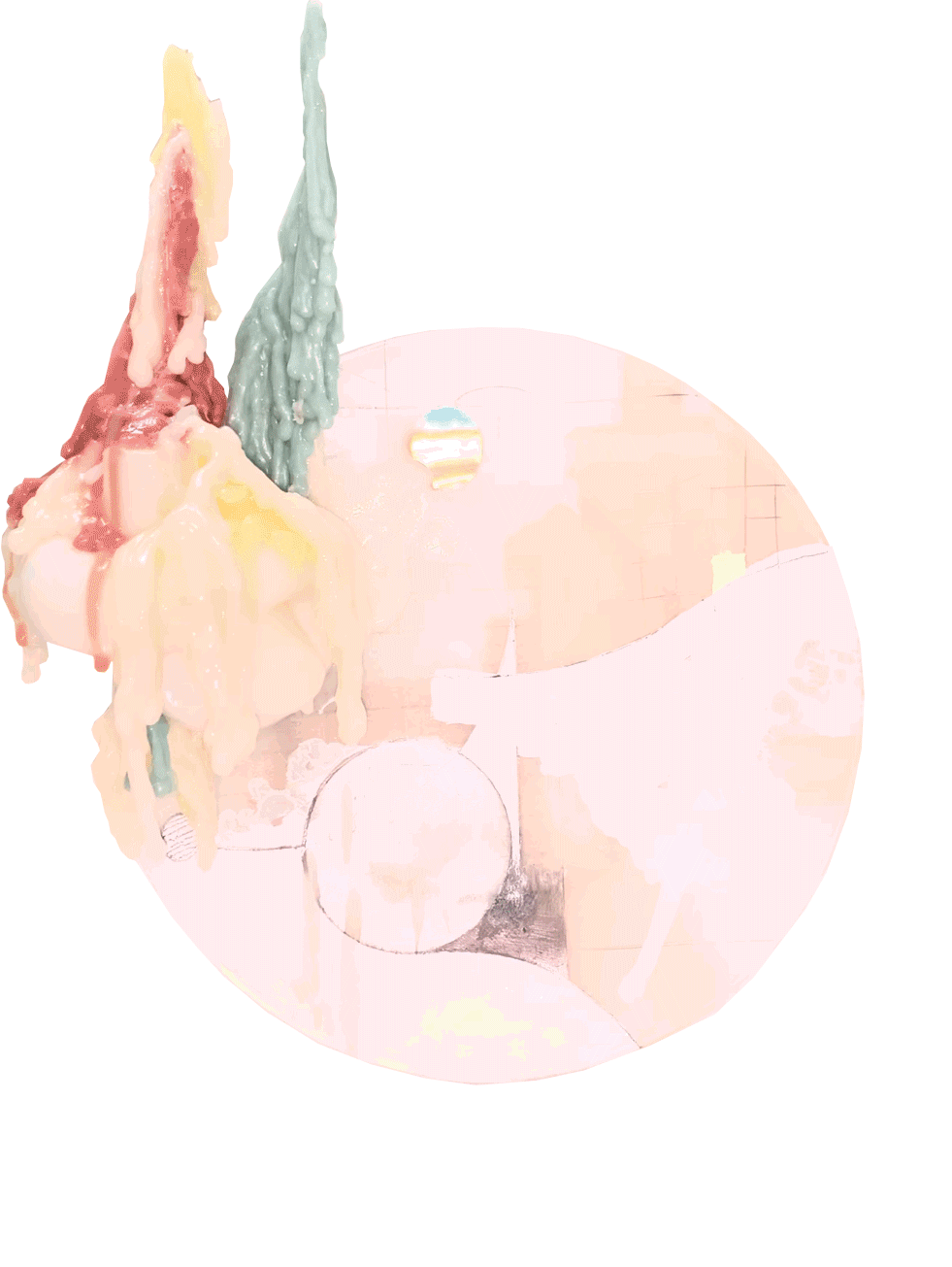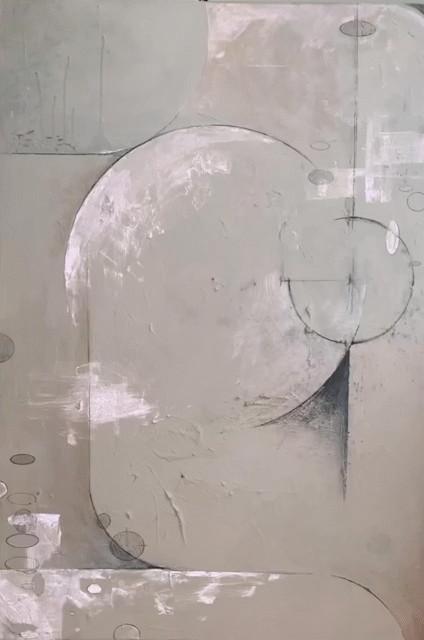
fig. 5
fig. 3
fig. 1
a. "지속" 에 대한 고찰
모든것이 '움직이거나 변화하는 상태로 존재'한다면
작품의 "완성"과 "지속성"의 정의는 어떻게 되는가;
a. A study on Durée
창작가이자 철학적 탐구를 하는 "나" [1] 에게
'작품이 '완성'되었다"가
정확히 어떤 순간과 상황에서 결정이 나는가,
예술품 복원을 연구하던 "나"[2] 에게
"마스터피스"를
어느 상태로 복원 하는 것이 옳은지 는
항상 고뇌에 빠지게 한다.
Continuity;



fig. 4
How does a work of art's Durée - duration - or
its 'completion', if the substance of the things we see is in constant change?
How does one decide
whether a work of art is "completed"
- is there a certain moment that makes the
creator/artist to feel so?
How does one decide
to which exact condition they should conserve
a masterpiece - as an art conservator?
fig. 2

fig. 1 - mixed media with found object; 61cm x 44cm;
fig. 2 - gesso, acrylics and graphite on canvas; 45.5cm x 65cm;
fig. 3 - graphite and acrylic on paper; 32cm x 44cm;
fig. 4 - mixed media and melted candle wax on glassware; 25cm x 25cm x 8cm;
fig. 5 - digital painting;

"판타레이" (아포리즘);
"만물은 유전하며 같은 상태로 존재하지 않으며
만물은 흘러가고 결코 머무는 일이 없다"는
고대 그리스 철학자 헤라클레이토스의
사상의 바탕을 나타내는 말;

"Panta Rhei" (aphorism);
Heraclitus's belief that
"all things move and nothing remains still"
which means everything is always
in a state of constant change;

카메라 등 전자제품의 "플래쉬"의 정의는
"순간적인 섬광을 발생시킴으로써 촬영 장면을 밝히는 장비"이다.
그러나
순
식
간
에
터
지
는
밝
은
빛
한번을 위한 "과정"* 이
항상 존재한다.



b. A study on
the process of
a flash
Process Philosophy
b. "플래쉬"가 터지는 과정에 대한 계사
-
플래쉬를 터트리고자 하는 (유저의) 의도,
-
(유저가 자신의) 의도에 따라 (기기에) 플래쉬를 설정하는 행동,
-
유저의 의도에 따라 기기가 “플래쉬”를 터트리기 위해 서킷이 파워서플라이의 ‘전류를 끌어올리는’ 과정,
-
그리고 ‘유저가 셔터를 누르는 순간’ 까지 기기와 유저의 대기,
-
유저가 셔터를 누름으로서 전류가 순간적으로 터지는 순간 - 플래쉬가 터짐 - 과 함께 기기가 다시 서킷을 준비/혹은/차단하는 동안
-
유저의 망막에 남는 밝은 빛의 잔상,
-
남은 사진/혹은/결과물 - 에 남는 “‘플래쉬’를 터트렸다”는 정보
*
'순간' 존재하는 플래쉬조차
이러한 "과정"을 언제나 거쳐가기에
베르그손의 과정철학에 의거,
"움직이거나 변화하는 순간"은
순수히 그 자체로 존재할 수 있다 -는
결론에 도달하였다.
fig. 1
fig. 2
fig. 3
fig. 4
fig. 5
fig. 1 - mixed media with found object; 61cm x 44cm;
fig. 2 - gesso, acrylics and graphite on canvas; 45.5cm x 65cm;
fig. 3 - graphite and acrylics on paper; 44cm x 61cm;
fig. 4 - mixed media and melted candle wax on glassware; 28cm x 28cm x 8cm;
fig. 5 - digital painting;



과정 (명사.)
過程
일반적으로는 사물이 단순히 잇달아서 경과하는 것을 의미하지만, 보다 정확히 말하면 여러가지 현상이 관련을 맺으면서 법칙적으로 진행하는 것, 혹은 어느 현상이 그 변화 속에서 규칙적으로 서로 다른 상태로 움직여 가는 것을 가리킨다.

Progress (n.)
/ˈprɑː.ɡres/
1. movement to
an improved or more
developed state, or to a forward position
2. happening or being done now

진전 (명사.)
過程
1. (목표 달성완성을 향한) 진척
2. (앞으로무엇을 향해) 감
3. 진전을 보이다; 진행하다

fig. 5

fig. 3
c. A study on
process/progress
사회에서 “과정”은 ‘미완성’의 정의에 가깝기에
“결과/물” - 즉 “완성” - 을 요구한다.
작가로서 의도적으로 “‘미완성 상태 - 과정 중 - 의 작업’을 담아내는 것이 ‘완성된 상태’라고 정의” 한다면
과연 이 작품은 완성된 것일까, 미완성일까?


fig. 2
fig. 1
fig. 4
나의 작업은 내가 의도한 “과정중”
- 즉 미완성이자 완성중인 상태 -
혹은 움직이거나 변화하는 상태-으로 존재하는 것 이기에
사회에게는 “미완성” - 즉 실패 - 이라고 여겨질까,
아니면 이러한 “과정중”을 성공적으로 achieve한
‘완성’의 상태이기에 작가로서는 실패일까?
completed incompleteness

c. 진전과 과정에 대한 생각
fig. 1 - mixed media with found object; 61cm x 44cm;
fig. 2 - mixed media, acrylics and graphite on canvas; 45.5cm x 61cm;
fig. 3 - graphite and acrylic on paper; 32cm x 44cm;
fig. 4 - mixed media and melted candle wax on glassware; 28cm x 28cm x 9cm;
fig. 5 - digital painting;

about the artist
Estelle YeonJu Song is a multidisciplinary artist and philosophy enthusiast from Seoul, Korea/Palos Verdes, California;
Heavily influenced by School of the Art Institute of Chicago's - where she got her BFA from - unique department of Art and Technology, she has been creating artworks with a "touch of technology";
Through her works of art, Estelle challenges arbitrariness of humans defining boundaries and concepts;

















